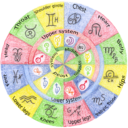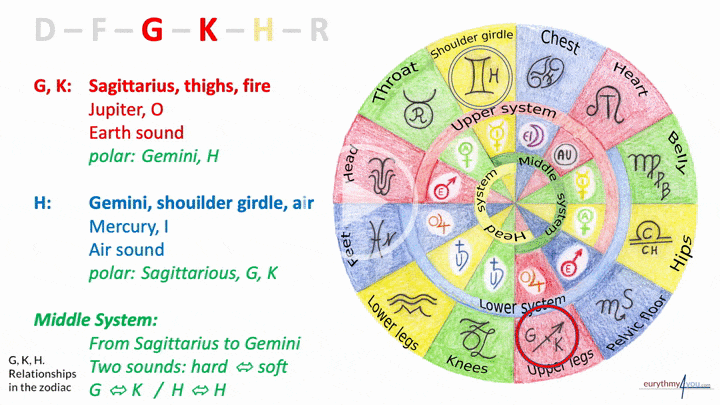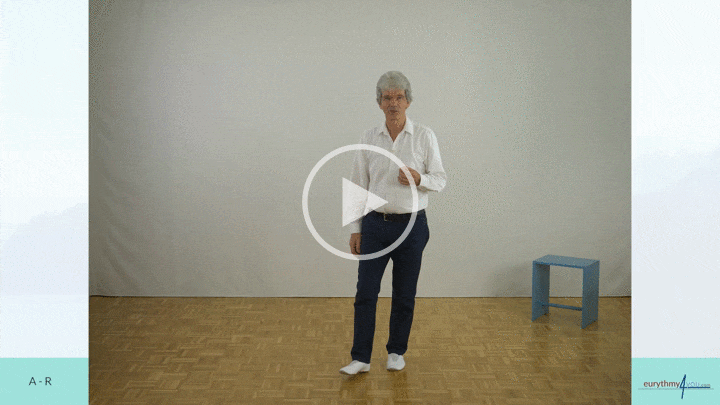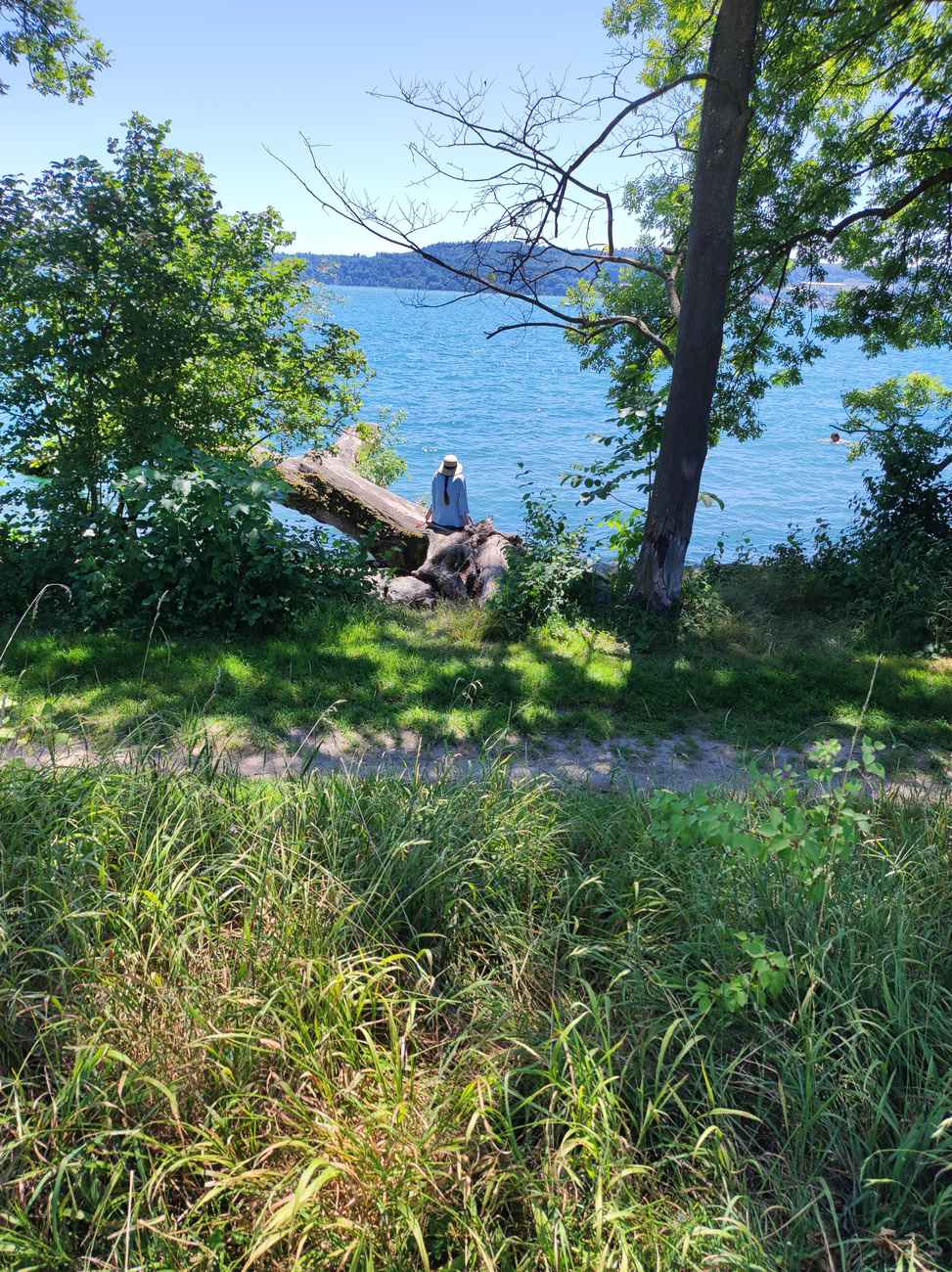Description of the calming sequence by Rudolf Steiner
In 1912 Rudolf Steiner taught the calming sequence D-F-G-K-H to 17-year-old Lori Meier Smits. Here is the original text she wrote down.
On the (second) day, Dr. Steiner continues on consonants as a reaction to external influence in contrast to the vowels, which weave entirely within and reveal this inner being.
D
That afternoon he began to describe a certain outside world: «Imagine a very beautiful, peaceful evening landscape. Not grandiose, but soft, gentle hills. In the background the sun is setting between two hills. A few white clouds stand still, motionless in the sky and look down on a lovely meadow valley. A small stream flows quietly, murmuring like a dream, trees and bushes stand on the edge of the river and are reflected in its still water, flowers bloom in the meadow, and on the slopes of the hills there are fruit trees full of ripening fruits. Perhaps there is still someone working quietly and calmly on one of the slopes in the distance, wrapped in this evening peace. Nature is completely closed in itself. And through this valley you walk, surrendered and absorbed in this calm mood, and with every thing, be it a tree, be it the sun, the clouds in the sky, the flowers and bushes of the meadow, the brook at your side, the person there in the distance, the fruits of the fruit trees, you feel at one and connected with everything and greet each and every one with this movement.»
Then he made an inexpressibly gentle, gently lowering hand movement with the palm of his hand pointing downwards, several times in a row, again and again lifting the relaxing hand upwards, and then again, stretching to the fingertips rather than stretching it downwards. It was like a leaf that had detached itself from its branch and, as if carried by the air, fell gently to the earth. “That is a D. Learn to experience it as a reaction to a dormant external influence. Practice it out of this mood and with everyone: This through you, turn to another thing in this outside world. You should be caught up in the mood just described and try to express it in the manner of the step."
In the end, Rudolf Steiner told us about a very different kind of oriental educator. He walks quietly next to or behind his pupil, points to everything around him, to stone, plants and animals, mountains and seas, the sky with all its lights and clouds, lets him feel and experience storms and thunderstorms, and the only thing he does is give his pupil the name of all these things. But his name is: the Dada. "And that is also a D. This through you."
F
Then his voice changed, he said briskly: “And now imagine that a violent gust of wind suddenly blows into this peace. The clouds darken the sun, the brook beats waves, trees and bushes lean deep into the water, the apples patter from the trees, the hat is blown off your head, and the person up there waves excitedly to you. Lots of questions and requests come towards you from the still peaceful outside world. "Pick us up", ask the apples, "get me back", the hat calls out, "don't come too close to me", the brook warns, "make sure you come under a protective roof", the man wants to say with his wave. And now you react with the same movement, but now very energetically and elastically. " And again he made the movement, always a short, energetic downward movement in all directions and an elastic bounce up again. “And this is how you learn to feel an F, a reaction to invigorating influence. For fiery feasts. Again try to express with your feet that you have understood this request."
G
But further I should try myself to picture an ugly, rejecting, revolting and disgusting, but for the time being, also self-contained, outer world down to the last detail and to imagine how he described this first, beautiful, peaceful, self-contained world. One should experience oneself placed in these too, but only reluctantly and reluctantly putting one foot in front of the other, executing a calm, but clearly defensive hand movement against each of these unveiled ugliness. "Learn to perceive G as a defensive reaction."
K
And if this outside world is also roused from its calm by something and assumes a malicious, threatening attitude, then this defense must be strengthened, in short, the G must then become a K, a similarly targeted gesture as before with the F. K stands for G as F for D.
H
But if you are really harassed and attacked, then you should defend yourself with an energetic repulsive movement. With an H-movement. "And if something completely Luciferic comes along, you can do it like that!" And smiling happily, he kicked his left leg quite forcefully, apparently for some imagined goal!
D F G K H
Rudolf Steiner then put together the five previously explained and briefly noted sounds DFGKH and said: “If you later have to deal with children or adults who are agitated, restless and nervous, then this DFGKH sound sequence can have a calming and relieving effect."
R
After the description of L M N P Q that followed, Rudolf Steiner spoke about R, about this being carried away - when the wind blows away. Of course, neither he nor I could pretend or try to do it in the small room. Dr. Steiner emphasized, however, very clearly that one had to try again and again to “catch the moment where the step merges into the run”.
R is neither calming nor stimulating, but neutral and reinforcing and should therefore be made and practiced every time after such a sound sequence.
Because "it brings all of the preceding into a correct relationship with what is already there". This is the literal meaning of this sentence, which has to be thought about a lot, but which one can quietly try out and experience on oneself with repeated, attentive action, namely when one tries again and again what Rudolf Steiner had said at the very beginning - bringing the heart into the head.
Then he talked about how one could come to a real experience of the consonants. You should really experience them intensely out in nature, which he had repeatedly cited and described that day. He said, “Go out and really let the wind blow you away in the R. See how reeds or grains, how bushes and trees are blown to and fro in the wind. Try to go along with all these movements, because you can also experience being carried away while standing. Or go down a steep slope and feel yourself start running. Also there is R."
From GA 277a: Origin and Development of Eurythmy, Dionysian Course, September 17, 1912
























